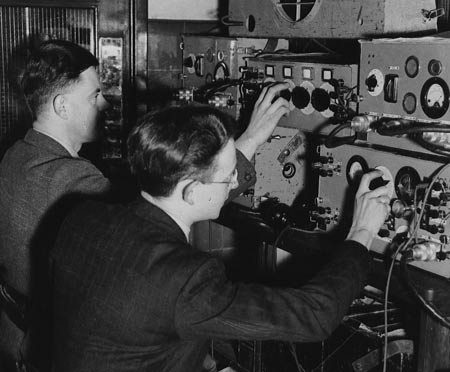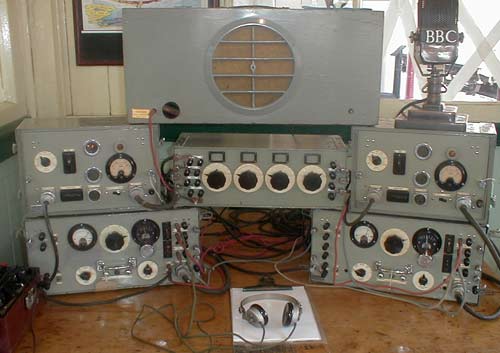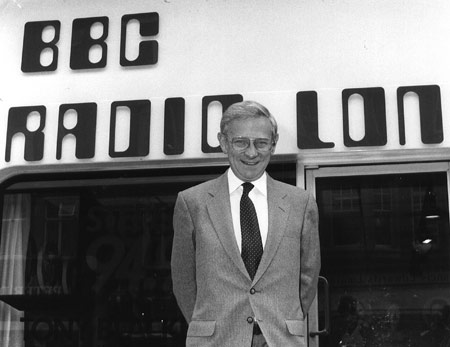
Johnny operating OBA/8 equipment.
As an outside broadcast engineer in the 1940s and 1950s, I was very familiar with this gear. I joined the Beeb at the height of the Blitz in 1940, and went straight into London OB Department as a Junior Maintenance Engineer without any knowledge of how a broadcast was made, no ab initio course or any sort of instruction then - but I did have a huge schoolboy enthusiasm for the job.
The BBC was very short of younger engineers at this time. Most of the OB engineers were 2LO veterans, ex-sea-going 'Marconi men' who were the only people around in the 1920s when the BBC was born, sufficiently knowledgeable to take on the job.
There were no training courses or qualifications in place, and the BBC found it was facing an ageing engineering staff nearing retirement, or younger ones being called up.
I was interviewed by H. O. Whiting in a room on the third floor of Bentinck House in Bolsover Street for a job as JME, and in mid-interrogation, an unexploded bomb which had been dropped during a raid the previous night, decided to go off.
There was a tremendous bang, and we were showered with window glass, cracking heads together as we dived for cover under the table.
That terminated the interview at a very fortunate moment, as I had just been asked a difficult question regarding the impedance of a 10 h choke and various AC currents being fed into it.
We were unhurt, apart from superficial scratches and almost total loss of hearing for a few hours - and to my surprise and delight I was subsequently told I had got the job. I was to report to R H Wood, the Engineer in Charge of London OBs in Chapel Mews, behind Broadcasting House.
The equipment then in use was unbelievably antiquated. We had the Type 1A amplifier, LSM/1 loudspeaker amplifier with a Rice Kellogg or Voigt loudspeaker, a set of 4 gang knife switches for line changing, and everything connected up via screw terminal posts.
This was all 1928 technology. The triode valves in the amplifier were on springy mountings to reduce microphony, and there was a 9 volt 'grid bias' battery to adjust for best results. It was all ebonite panels and mahogany cases.
Everything was battery-operated - wet accumulators for valve filaments and very heavy boxes of HT batteries.
Sound levels were measured on a line volume meter (no PPMs then), which had a wildly fluctuating needle, and the main gain control - which operated in the centre of the amplifier panel on a six-inch extension handle to avoid capacitance effects - in 3dB steps!

A typical OBA/8 setup. The OBA/8s themselves are sitting
on the table. They contained the amplification, gain control and PPM.
Sitting on them are the MU/3 power supplies and bridging them is the
passive MX/18 four channel mixer with the LSU/1 above. It was usual
to have duplicate equipment in case of failure.
I was doing a Workers' Playtime at a biscuit factory in Reading (billed as 'somewhere in England'). We had a precious set of OBA/8s with MU/3 power supply and MX/18 four-channel mixer, and an LSU/1 loudspeaker for this show, together with 250v boxes of HT batteries, and two sets of 6v wet accumulators.
Travel was by first class train in those days mainly because it allowed a greater weight allocation of baggage - our gear - to be put into the guard's van.
However, on our return, we were halted outside London by an air raid, and eventually crept into Paddington in the small hours of the morning. We crunched our way over broken glass and rubble, and bribed a taxi to take us, and our gear, to Chapel Mews.
When we finally got back to our OB base, we found a water-filled crater where it used to be. Chapel Mews had been bombed; The Jolly Scotsman pub on the corner was gone!
What do we do? A while later, we were told to take the gear to temporary premises at 19a Cavendish Square. Returning to the bombsite, we found a lot of the old 1928 equipment lying around, including a much-resented, extremely heavy OBA/7 in a mahogany case, and various other very unpopular items. All were due to be replaced by the more modern OBA/8s.
Funnily enough, much of this old and heartily loathed equipment was very close to the edge of the crater, and we were amazed - and secretly delighted - to find most of our newly-provided OBA/8s were further away. The inevitable consequence was that from then on, we were almost fully equipped with OBA/8s.
Perhaps during the recent rebuilding on the area behind Broadcasting House the excavators may have found some interesting relics of early OB equipment, though quite how it would have got there I really couldn't say…

Johnny outside BBC Radio London.
It was with great sadness that I learned of Johnny's death just short of his 89th birthday after a very short illness.
With his irrepressible sense of humour, healthy disrespect for management and lateral approach to technical problems he managed to create innovative equipment which was well liked, and thus respected, by its users; a principle I always strived to imitate. In this way John managed to carve out a niche in broadcasting engineering history which will endure for a long time.
Johnny, I learned so much from you at the beginning of my BBC career for which I will always be grateful. I was proud to be called your minion!
To have made such a mark in our business while being liked, respected and remembered by many colleagues is an aspiration for all.

